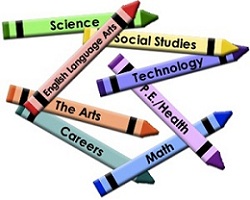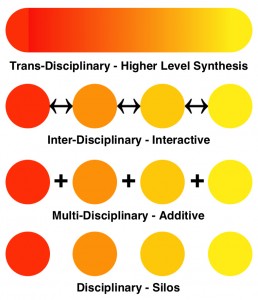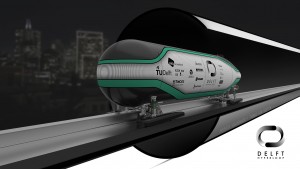 Also at my university, though rigidly organised in disciplinary silos and producing disciplinary programmes, I hear the buzzwords “multidisciplinarity” and “interdisciplinarity” almost every day. Obviously there is a shift of interest towards exploring questions and solving problems that cross borders and engage with experts from multiple fields. Quite some universities in Europe, the Americas and Asia make even bigger steps. They develop “liberal engineering” study programmes with the aim to bring broader education with more holistic thinking and societal context to engineering students.
Also at my university, though rigidly organised in disciplinary silos and producing disciplinary programmes, I hear the buzzwords “multidisciplinarity” and “interdisciplinarity” almost every day. Obviously there is a shift of interest towards exploring questions and solving problems that cross borders and engage with experts from multiple fields. Quite some universities in Europe, the Americas and Asia make even bigger steps. They develop “liberal engineering” study programmes with the aim to bring broader education with more holistic thinking and societal context to engineering students.
Interdisciplinarity: a buzzword that will go away?
But do we know what the term “interdisciplinarity” actually means? When do we call education or research projects interdisciplinary? How do we challenge students to step across the disciplinary borders? How would an interdisciplinary curriculum look like? These were among the many questions that were addressed at the first National Interdisciplinary Education Conference in Amsterdam February 2nd. In another post I will address this conference separately. But first let us see why interdisciplinarity gains prominence.
Gaining prominence?
When I visit websites of innovation and integrated research institutes, I notice interdisciplinary research is more prominent on their agendas than five years ago. That trend slowly trickles down in our education. Or maybe it is the other way around: graduates who learnt the interdisciplinary mindset in their study initiate research in a broader context: Research follows Development (the sequence is reversed from R&D to D&R).
“We are not students of some subject matter, but students of problems. And problems may cut right across the boundaries of any discipline”. (Quote Karl Popper, 1963).
Also at the 18 January kick-off meeting, where I was one of the 80 participants who committed to develop the Strategic Framework for TU Delft 2018-2024, I heard “multidisciplinary” and “interdisciplinary” among the most frequently used words. And reading the 80% version of the 18-page TU Delft’s new Vision on Education, you can’t miss this trend. Is n’t it remarkable that the words multi-, inter- and transdisciplinary show up 19 times in the text, while other “modern” skills such as leadership, creativity and ethics are only mentioned zero, one and two times respectively?
Interdisciplinary engineering: a wave of the future?
Those of you who have read my vision document on engineering education may know my ideas about interdisciplinarity. I do not expect it to be a buzz word. In the domain of engineering and many other professions it is there to stay. Interdisciplinary thinking becomes increasingly important, but in balanced partnership with disciplinary expert thinking. Innovation needs excellent, talented specialists ánd people who are able to cross disciplinary borders. And I expect that in the near future also specialists have to be able to move more easily between the detailed level and the bigger picture.
The world is changing at an increasing pace. Complex societal and engineering challenges such as climate change, infrastructures in urban settings, cyber security, digital well-being, energy transition, health care, they all demand solutions that cross traditional disciplines. Recruiters of engineering businesses show a growing interest in engineers and other professionals who have proven to be able to acquire and apply specialist knowledge and look across the boundaries of their expertise. People who are capable to build bridges between technology, government, businesses and social institutions have higher value.
Is this new? Not really. Dougherty’s quote 60 years ago, tells us that engineers have always needed multiple skills to operate successfully in multi- and interdisciplinary environments. But since the end of World War II policy makers in engineering education have found it necessary to deviate from what society needs, with deeper specialisations and more fragmentation.
“The ideal engineer is a composite…
He is not a scientist, he is not a mathematician, he is not a sociologist or writer. But he has to use the knowledge and techniques of any or all of these disciplines in solving engineering problems.” (Quote N.W. Dougherty, 1955)
Trends in disciplinary and interdisciplinary education
In job advertisements I read that companies seek candidates with skills in computational sciences ánd safety, biology ánd chemistry, engineering ánd finance, human engineering ánd robotics, medicine ánd mechanical engineering. Today’s problems apparently require teams that can work together to address problems from different and innovative angles. The best strategy for defining and solving complex problems is bringing people together who havep different backgrounds, who can quickly learn new knowledge, have respect for different disciplines, are willing to share knowledge and connect their scientific curiosity to societal concerns.
Innovation cycles are getting faster. Many development projects typically last two to three years at most. Projects in industry and research often last less than one year. Companies therefore need to find people who can quickly learn new fields and are open towards and respect other people’s views. Don’t get me wrong here. We have to remain teaching our students the rigour of engineering fundamentals in their discipline. But in order to stimulate them to cross boundaries and connect to the real world, we should add early exposures to other areas too. It will make them better engineers or scientists in their discipline because they are forced to learn about the strengths and weaknesses of their own field.
Interdisciplinarity involves much more than knowledge about a second or third discipline. It is equally important to learn how to think in a way that is different from the way you think as a specialist in your own field. We should make students aware that engineers and scientists in different disciplinary domains speak different “languages”, sometimes don’t (want to) understand each other. It makes communication and collaboration between different disciplines complicated and prone to errors. Not seldom is it a source of friction and conflict. Interdisciplinary thinking means that people have respect for each others’ discipline, and understand that under the surface, everybody is engaged in surprisingly similar ideas and concepts.
Multi-, inter- or transdisciplinarity?
The words “multidisciplinary”, “interdisciplinary” and “transdisciplinary” get thrown around a lot today. Key characteristics in multi- and interdisciplinary education and research are the integration of elements and a bridging and symbioses between different disciplines. They have in common that they are averse to disciplinary ego-centrism.
In multidisciplinary projects each discipline contributes a piece of the puzzle. But this is not integrated along the way. When I worked in spaceflight industry in my former life on the design and development of highly advanced space instrument, the Structural and Optical Departments worked on one and the same instrument design, detached from each other, each designing and analysing their own specialism. By some “interaction” the lenses and mirrors were eventually mounted, aligned and fixed through the structural elements.

Multi-, Inter-, Trans-disciplinary work. Source: University of Technology Sydney
Interdisciplinary ways of working realise integrated ways of working and solutions. If we consider Multidisciplinary as an equivalent for Additive, then Interdisciplinary is an equivalent for Multiplicative. Interdisciplinary work blurs the boundaries between disciplines and tears down the walls. In my above mentioned space instrument design it was my responsibility as a Systems Engineer, a truly interdisciplinary function indeed, to link and harmonise the mechanical and optical requirements and detailed designs to ensure one integrated design. This also applied to electrical, thermal, radiation protection, mechanisms and electronic subsystems, all within the domain of engineering. I designed and controlled interdisciplinary mass and power budgets, performed Contamination engineering, Reliability, Availability, Maintainability and Safety (RAMS) engineering. Each of these design parameters is influenced by all subsystems and disciplines, but does not belong specifically to any of them. Systems Engineering is interdisciplinary, within the domain of engineering. From personal experience I know that systems engineering is a very social activity also. Collaborating with people with different priorities and interests, with different cultures and backgrounds, speaking different languages. It requires oversight over technical disciplines, engineering skills as well as personal leadership, knowledge and insight of enterprise management, knowledge management, project management, certification and so on.
To be honest, I had never heard about the silly term trans-disciplinary when I was employed in industry. It is a term that is only used in academics when research involves knowledge beyond the professional experts and scientists. This may be lay-mans knowledge, and knowledge and understanding of politics, technical acceptance, enterprise management and finance control. In the non-academic world, such split between trans- and interdisciplinary is completely artificial and does not exist. Real-life projects are always interdisciplinary, where non-scientific aspects are all in the game.
Levels of interdisciplinarity
Talking about interdisciplinarity in academia can be confusing. There are so many different levels of interdisciplinarity. If I ask a specialist in humanities or social sciences to collaborate with an engineer, no matter what discipline, he or she will say the work is likely going to be interdisciplinary. If I ask mechanical engineers to collaborate with industrial design engineers, they will perceive it as interdisciplinary work. And if I ask an aerospace engineer who is highly specialised in light-weight structures to collaborate with his fellow aerospace engineer who is specialised in manufacturing engineering, he will state this is interdisciplinary work also. The trend to ever deeper specialisations leads to fragmentation and generates new disciplines, like the “super-specialisations” in composite material engineering or nanotechnology. It could make collaboration between a composite materials specialist and a structural engineer already interdisciplinary, in spite of these two fields being so closely related.
The complexity is further increased by fusions of disciplines into a new one. Such new discipline may have an interdisciplinary origin, but once it is there, it could also be considered as a new mono-discipline. Take the example of the fusion between mechanical engineering and medicine. It has generated the new discipline Medical Technology. Education or research in this new mono-discipline has an interdisciplinary origin…
Interdisciplinary education: added value?
My intuition tells me that teaching interdisciplinary skills is only valuable for students when they learn to appreciate another discipline and its “language”, if it has sufficient “distance” to their own discipline. Suppose I split the engineering domain into three categories: Engineering (Mechanical, Civil, Electrical Engineering), Design (Industrial Design, Architecture) and Sciences (Applied Sciences, Mathematics, Computational Sciences). Some level of interdisciplinary learning could be achieved when students from one category learn the language of one of the other categories. But still, I believe this is interdisciplinary learning in the margin: it’s all within the single engineering domain.
The essence of interdisciplinary learning is achieved when engineering students learn to connect their domain also to societal context and relevance. For which they have to learn how to share knowledge, how to debate, communicate and collaborate with students and professionals with backgrounds in social sciences or humanities, or with lay-man. What is the limitation of interdisciplinarity within the engineering domain only? No matter what engineering discipline, all engineers rely on analytical skills, are problem solvers and rational and creative thinkers. While lawyers, philosophers or economists have a very different appreciation of what engineers do, no matter whether they design nanometre level strings of polymeric molecules or megaton offshore oil rigs.
Opportunities and courage
“Interdisciplinarity is crucial for the development of excellence.”
(Quote prof. Rane Willerslev at the Excellence 2012 Conference)
Obviously we will never be able to teach all this in our classrooms. Engineers and professionals need a lot of learning on the job to build up interdisciplinary experience. But what we should do in our classrooms is better introduce the interdisciplinary mindset and train staff to be mindful to the students by crossing their borders also. Given the growing need for cross-disciplinary competences in the labour market, the question rises whether we should develop dedicated cross-disciplinary Master programmes? The question could be a yes or no. It all depends on who we want to be as a university.
My home university has a strong reputation in disciplinary knowledge, and I expect also in the future disciplines will remain leading the profile of the Delft engineer. Does it match with our dominant culture to develop more Master programmes where we educate and investigate interdisciplinary topics by bringing Bachelor graduates in different engineering disciplines together and educate them in the full range of an interdisciplinary subject? Or should we develop hybrid Master programmes where students still acquire specialist disciplinary knowledge at their faculty? And bring that deep disciplinary knowledge on Master’s level to a hub where they investigate interdisciplinary problems in teams of students who have different disciplinary expertise, while they are also trained in interdisciplinary thinking?

Hyperloop is the most recent success of the many successes of the 14 so-called DreamTeams of TU Delft students. The student teams work hard with an interdisciplinary mindset and demonstrate that they can push boundaries further than anyone expects.
TU Delft has already a place where students work and learn together with students from other faculties and cultures, and other stakeholders: the D:Dream Hall, the working space of the Dream Teams. These interdisciplinary teams spend all their leisure time to extracurricular activities and are incredibly successful. This is the place where people learn how to engineer. I wish we could copy the concept of these student teams to our regular education for all our students.
And I think we can if we have the courage to change.
TU Delft has a vast number of research institutes where scientists do research in collaboration with public and private sectoral organisations: the Deltas Infrastructures and Mobility Institute, Delft Robotics Institute, Safety & Security Institute, Sports Engineering Institute, Space Institute, to mention a few. We are also developing Living Labs, such as the Innovative Airport by the faculty of Aerospace Engineering and the Amsterdam Institute for Advanced Metropolitan Solutions (AMS) by the faculty of Architecture and Built Environment. Today these research institutes are the prime territory of researchers and PhD students. Bachelor or master students are hardly involved. This year the faculty of Industrial Design Engineering has initiated a number of Design Labs specifically for their master students: the Cardiology Lab, the Museum Futures Lab, the Workspace Design Lab, the Future Travel Experience Lab, the Active Materials Lab. Last but not least the faculty of Aerospace Engineering has plans to develop an Aerospace Innovation Centre for staff, students and professionals.
I identify the research labs and institutes as potential hubs in the future where engineering students can develop their interdisciplinary skills as part of their regular study programme by developing multi-faceted solutions to our most pressing engineering challenges. Let us organise these hubs flexibly around high-tech “hot topics”. I would expect the students will become the driving force behind the projects and ideas in these hubs, just as in the Dream Hall. Since they come from different background, they bring their own disciplinary expertise and will study different ideas. These projects will have more relevance, more public engagement and more connections to society. The students work in collaborative teams of students from different engineering disciplines, in the future maybe complemented by students in Liberal Arts and Sciences from Leiden University and Erasmus University Rotterdam.
I am not a strategic analyst but dare to forecast that the learning gains of the students and the output of such interdisciplinary research and design projects in these hubs will be more engaging and have more impact on our innovation ecosystem and the outside world than most of the research output of today’s mono-disciplinary master projects. All we need is the courage to change.
Postcript
In summer 2017 I had dinner with a lecturer who teaches historical and contemporary creativity in various forms. He gave me an interesting view on disciplinary and interdisciplinary thinking. He said there exist three distinctive categories of professions/disciplines, which are:
- professions that are all about written text (economists, lawyers, journalists, etc)
- professions that are all about 2D visualisation (painters, photographers, web designers, etc)
- professions that are all about 3D-shapes and 3D-visualisation (puppetry, theatre, engineers, designers, virtual-reality (VR) developers, etc)
People in each of these groups have a similar way of thinking. And thus, we concluded after a glass of wine, that interdisciplinary thinking must have most impact in collaborative activities when we put people from these three groups together.



